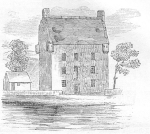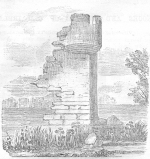Mongevlin Castle, County Donegal
From the Illustrated Dublin Journal, Volume 1, Number 33, April 19, 1862
 MONGEVLIN Castle, the subject
of the prefixed engraving, is situated in the county of Donegal, on the
banks of the Foyle, about seven miles from Londonderry, and one from
the village of St. Johnstown. It is thus mentioned in Captain Pynnar's
Survey of the Escheated Counties of Ulster, in 1619:--"Sir John Stewart
hath three thousand acres, called Cashell, Hetin, and Littergull. Upon
this proportion there is built, at Magevlin, a very strong Castle, with
a flanker at each corner."
MONGEVLIN Castle, the subject
of the prefixed engraving, is situated in the county of Donegal, on the
banks of the Foyle, about seven miles from Londonderry, and one from
the village of St. Johnstown. It is thus mentioned in Captain Pynnar's
Survey of the Escheated Counties of Ulster, in 1619:--"Sir John Stewart
hath three thousand acres, called Cashell, Hetin, and Littergull. Upon
this proportion there is built, at Magevlin, a very strong Castle, with
a flanker at each corner."
The walls of the court-yard and gate-way, erected between the Foyle and the Castle, were standing till within a few years ago. A small stone flag, with the following inscription, was built in the arch:
I. S.
E. S. T.
1619.
This stone has been lost, but another remains, bearing the following inscription:--"The Hon. Elizabeth Hamilton, daughter of John, Lord Culpeper, and widow of Colonel James Hamilton, (who lost his life at sea, in Spain, in the service of his kirg and country,) purchased this manor, and annexed it to the opposite estate of the family, which paternal estate itself has improved by her prudent management, to nearly the yearly income of the dower she received thereout. She hath also settled her younger son, William Hamilton, Esq., in an estate acquired in England, of nearly equal value in the purchase to this, and given every one of her numerous offspring, descended from both branches, some considerable mark of her parental care. Her eldest son, James, Earl of Abercorn, and Viscount Strabane, hath caused this inscription to be placed here for the information of her posterity. Anno 1704."
James II. stopped here for a short time during the siege of Derry; and from this place he sent proposals of surrender to the garrison, by his host, Archdeacon Hamilton.
In connection with the history of Mongevlin Castle, the fertile imagination of the peasantry has conjured up many legends. They are, however, but "airy nothings," having not the slightest foundation of truth, either as regards the events depicted, or the actors concerned.
 The Earl of Abercorn derives the title of Baron Mountcastle, from Mount
Castle, county Tyrone, at one period an edifice of very
considerable extent, but of
which the above engraving represents all that now remains. It is
supposed to have been erected in the early part of the seventeenth
century. Adjacent to the ruins is a fine prospect of the surrounding
country; which presents that variety of appearance, hill and dale,
mountain and valley, which invariably characterizes the province of
Ulster. To the west is seen the river Foyle, winding through the rich
and well-cultivated parish of Clonleigh, with the numerous fine
plantations and snug farmhouses appearing on its banks; and the
prospect is bounded, in that direction, by the mountains of Donegal,
appearing dim and indistinct in the far distant horizon.
The Earl of Abercorn derives the title of Baron Mountcastle, from Mount
Castle, county Tyrone, at one period an edifice of very
considerable extent, but of
which the above engraving represents all that now remains. It is
supposed to have been erected in the early part of the seventeenth
century. Adjacent to the ruins is a fine prospect of the surrounding
country; which presents that variety of appearance, hill and dale,
mountain and valley, which invariably characterizes the province of
Ulster. To the west is seen the river Foyle, winding through the rich
and well-cultivated parish of Clonleigh, with the numerous fine
plantations and snug farmhouses appearing on its banks; and the
prospect is bounded, in that direction, by the mountains of Donegal,
appearing dim and indistinct in the far distant horizon.
